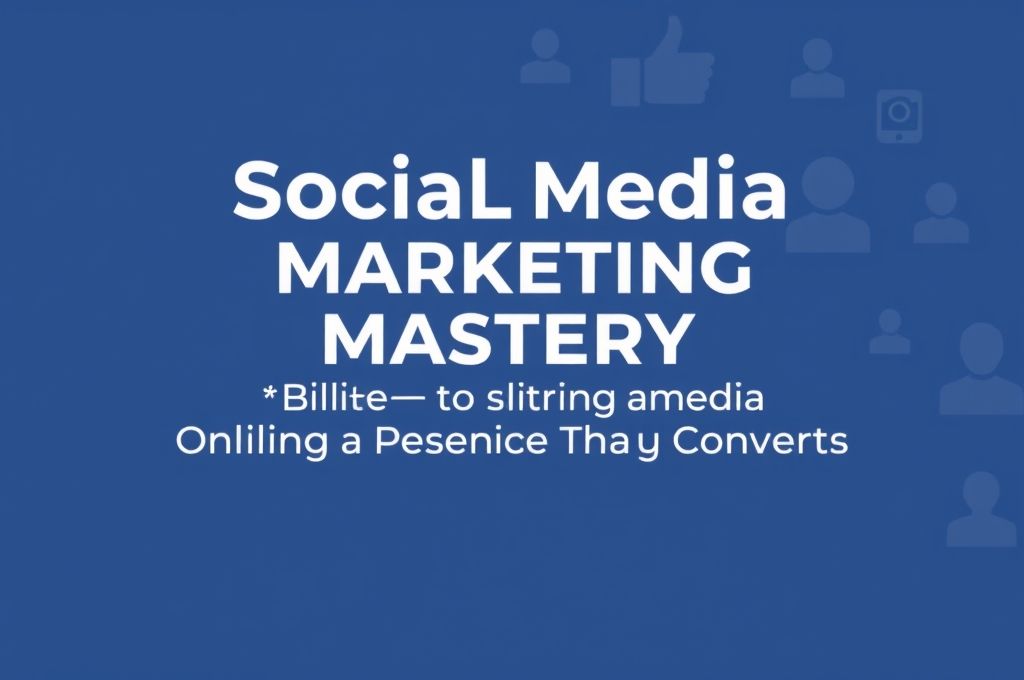Introduction: Why Your Online Presence Matters More Than Ever
Imagine this: you’ve just launched a new product or service. You’re excited, confident it solves a real problem, and you know people need it. But when you check your social media, the likes are few, the comments are sparse, and worst of all—no one’s buying. Sound familiar?
You’re not alone. Millions of businesses and creators face the same challenge every day. The truth is, having a social media account isn’t enough. In today’s digital world, success doesn’t come from simply showing up—it comes from showing up the right way. That’s where social media marketing mastery comes in.
We live in an age where over 4.9 billion people use social media worldwide. Platforms like Instagram, TikTok, Facebook, LinkedIn, and X (formerly Twitter) aren’t just for sharing memes or vacation photos—they’re powerful tools for building brands, connecting with customers, and driving real sales. But with so much noise, how do you stand out? How do you turn followers into fans, and fans into paying customers?
In this article, we’ll break down exactly how to build a strong online presence that doesn’t just look good—but actually converts. From defining your brand voice to creating content that sells, from understanding algorithms to engaging authentically, we’ll cover the practical, proven strategies that work in 2024 and beyond.
No fluff. No robotic jargon. Just real insights you can start using today. Whether you’re a solopreneur, a small business owner, or a marketing professional, this guide will help you turn your social media from a passive profile into a powerful growth engine.
Let’s dive in.
1. Know Your Audience Like a Close Friend
Before you post a single photo or write a caption, ask yourself: Who am I talking to?
This might sound obvious, but you’d be surprised how many brands skip this step. They post content they think is cool, trendy, or “on-brand,” only to wonder why no one engages. The problem? They’re not speaking to anyone in particular.
Your audience isn’t “everyone.” It’s a specific group of people with real problems, desires, and habits. To connect with them, you need to understand them deeply.
Start by creating a customer persona. Think of it like writing a character sketch for your ideal follower. Give them a name, age, job, hobbies, and even challenges they face daily. For example:
Meet Sarah, 32, a freelance graphic designer. She works from home, juggles client deadlines, and wants to grow her personal brand. She’s active on Instagram and LinkedIn, loves quick tips, and follows creators who are honest, helpful, and don’t take themselves too seriously.
Now, when you create content, ask: Would Sarah care about this? Would it help her? Would she share it with a friend?
Why this works:
When you speak directly to a specific person, your message becomes more personal, relatable, and effective. You stop broadcasting and start conversing.
Pro Tip:
Use social media analytics to learn more about your audience. Most platforms (like Instagram Insights or Facebook Audience Insights) show data on age, location, gender, and even the times they’re most active. Use this to refine your strategy.
Action Step:
Spend 30 minutes today writing down your ideal customer’s profile. The clearer you are, the better your content will resonate.
2. Define Your Brand Voice—And Stick to It
Now that you know who you’re talking to, it’s time to decide how you want to sound.
Your brand voice is the personality of your business on social media. Is it playful? Professional? Witty? Warm? Think of it like your tone when you talk to a friend—consistent, authentic, and unmistakably you.
For example:
- Glossier uses a friendly, inclusive, and minimalist tone.
- Duolingo (yes, the language app) is known for its hilarious, meme-loving owl mascot and edgy humor.
- HubSpot stays professional yet approachable, offering value-driven content with a human touch.
Why consistency matters:
When your voice is consistent, people begin to recognize you—not just by your logo, but by the way you communicate. It builds trust and familiarity.
How to find your voice:
- List 3 adjectives that describe your brand (e.g., bold, compassionate, innovative).
- Write sample captions in different tones. Read them aloud—do they sound like you?
- Get feedback from your team or audience.
Common mistake:
Trying to be everything to everyone. If you switch from serious business advice to sarcastic memes in the same feed, it confuses your audience.
Pro Tip:
Create a simple brand voice chart with dos and don’ts. For example:
- ✅ Do: Use contractions (“you’re” instead of “you are”) for a casual feel.
- ❌ Don’t: Use industry jargon unless you’re speaking to experts.
When your voice is clear, your content flows naturally—and your audience knows exactly what to expect.
3. Create Content That Educates, Entertains, or Inspires
Here’s a hard truth: no one cares about your brand. Not really.
They care about themselves—their problems, their goals, their time. So if your content only talks about your product, you’re missing the point.
The best social media content follows the 80/20 rule:
- 80% of your posts should give value—educate, entertain, or inspire.
- 20% can be promotional—talking about your offers, sales, or services.
Think of it like being a great guest at a party. You wouldn’t show up and only talk about yourself, right? You’d listen, share stories, make people laugh. That’s how you build real connections.
Types of value-driven content:
- Educational: “3 ways to organize your inbox in 10 minutes.”
- Entertaining: A funny skit about Monday mornings.
- Inspirational: A customer success story or behind-the-scenes look at your journey.
Real example:
A fitness coach could post:
- 📚 Tip: “How to stay motivated when you’re tired.”
- 😂 Fun: “When your dog steals your yoga mat.”
- 💪 Inspiration: “Client transformation: from 3x/week to running a 5K.”
Over time, this builds trust. When you do promote something (“My 4-week program opens next week!”), your audience is more likely to listen—because you’ve earned their attention.
Pro Tip:
Use the “So what?” test. After writing a caption, ask: So what? Why should my audience care? If the answer isn’t clear, revise it.
Value isn’t just about free tips—it’s about making people feel seen, understood, and supported.
4. Master the Art of Storytelling (Even If You’re Not a Writer)
People don’t remember facts. They remember stories.
Think about the last brand you loved. Was it because of a clever ad? Or because they made you feel something?
Storytelling is one of the most powerful tools in social media marketing. It humanizes your brand, builds emotional connection, and makes your message unforgettable.
You don’t need to write a novel. A simple story can be just a few sentences long.
Example:
“Three years ago, I was working 60-hour weeks, burned out and unsure of my path. I started this business in my kitchen with $200 and a dream. Today, we’ve helped over 1,000 people do the same. If I can do it, so can you.”
That’s not just a bio—it’s a journey. And journeys inspire action.
Types of stories to share:
- Your origin story: How and why you started.
- Customer wins: Real results from real people.
- Behind-the-scenes: The messy, real moments behind the scenes.
- Failures and lessons: Showing vulnerability builds trust.
Why it works:
Stories activate the brain in a unique way. They release oxytocin (the “trust hormone”) and make people more likely to remember and share your message.
Pro Tip:
Use the “Hero’s Journey” framework in your posts:
- The problem (struggle, pain point).
- The turning point (discovery, solution).
- The transformation (how life changed).
Even a single post can follow this arc. For example:
“I used to hate posting on social media. I felt awkward, salesy, and invisible. Then I learned one simple strategy: focus on helping, not selling. Now, I get DMs every week from people saying my content changed their business. You don’t need to be perfect—just real.”
Stories don’t sell products. They sell belief. And belief drives action.
5. Choose the Right Platforms—And Use Them Strategically
Here’s a common mistake: trying to be everywhere at once.
You don’t need to be on every platform. You need to be on the right platforms.
Each social network has its own culture, audience, and content style. Posting the same content everywhere is like wearing a tuxedo to the beach—it just doesn’t fit.
Let’s break down the major platforms in 2024:
| Visual brands, lifestyle, fashion, food | Reels, Stories, carousels | 18–34, mostly mobile users | |
| TikTok | Viral content, trends, entertainment | Short-form videos | Gen Z, Millennials |
| Community building, local businesses | Groups, live videos, posts | 25+, diverse demographics | |
| B2B, professionals, thought leadership | Articles, carousels, videos | Professionals, decision-makers | |
| X (Twitter) | News, opinions, real-time engagement | Short tweets, threads | Journalists, influencers, tech-savvy users |
How to choose:
- Where does your audience spend time?
- What type of content can you create consistently?
- What’s your goal? (Brand awareness? Leads? Sales?)
Example:
A B2B SaaS company should focus on LinkedIn and Twitter, sharing industry insights and case studies. A handmade jewelry brand? Instagram and Pinterest are ideal for visual storytelling.
Pro Tip:
Start with 1–2 platforms and master them before expanding. It’s better to have 10,000 engaged followers on one platform than 1,000 scattered across five.
And remember: platforms change fast. TikTok wasn’t even a thing five years ago. Stay flexible, test new formats, and keep learning.
6. Optimize for the Algorithm—Without Losing Your Soul
Let’s talk about the elephant in the room: the algorithm.
Every platform uses an algorithm to decide what content gets seen. And yes, it can feel like a mystery. But here’s the good news: you’re not powerless.
While you can’t control the algorithm, you can work with it—by creating content that people genuinely want to engage with.
Key factors that boost visibility:
- Engagement: Likes, comments, shares, saves.
- Watch time: How long people watch your video.
- Relevance: Does your content match what the user usually engages with?
- Consistency: Posting regularly signals activity.
What this means for you:
- Post when your audience is online (check your insights).
- Encourage comments with questions (“What’s your biggest challenge with X?”).
- Use captions to keep people reading (not just scrolling).
- Create Reels or short videos that hook in the first 3 seconds.
But here’s the trap:
Chasing virality at the cost of authenticity. Don’t force trends that don’t fit your brand. A forced dance on TikTok won’t help if it alienates your audience.
Better approach:
Use trends strategically. For example:
- A financial advisor could jump on a trending sound to explain “3 money mistakes to avoid.”
- A therapist could use a popular meme format to talk about anxiety.
Pro Tip:
Save high-performing content to a “Top Posts” highlight on Instagram. This keeps your best work visible—even if the algorithm changes tomorrow.
The algorithm rewards value + engagement. Focus on those, and the reach will follow.
7. Turn Followers Into Customers (The Conversion Mindset)
You’ve built an audience. Now, how do you turn them into paying customers?
This is where many brands get stuck. They have thousands of followers but few sales. Why? Because they’re not guiding their audience to the next step.
Conversion isn’t pushy—it’s helpful. It’s about making it easy for people to say “yes.”
Start by mapping out your customer journey:
- Awareness: They discover you (through a post, ad, or recommendation).
- Interest: They engage (like, comment, follow).
- Consideration: They visit your website, read your bio, or check your offers.
- Action: They buy, sign up, or book a call.
Tools to drive conversion:
- Bio links: Use tools like Linktree or Beacons to direct traffic to multiple offers.
- Clear CTAs: “Click the link in bio,” “DM me for details,” “Join the waitlist.”
- Lead magnets: Offer a free guide, checklist, or trial in exchange for an email.
- Stories with polls or swipe-ups: Interactive content builds engagement and moves people forward.
Real example:
A coach might post:
“Struggling to set boundaries at work? Grab my free ‘No More Overwhelm’ guide → link in bio.”
That’s not a sales pitch. It’s a solution to a problem.
Pro Tip:
Don’t wait until you have 10,000 followers to sell. Even with 100 engaged followers, you can make your first sale. Start small, test, and refine.
Remember: every post should have a purpose. Whether it’s to educate, entertain, or convert—know what you want the outcome to be.
8. Engage Like a Human—Not a Bot
Here’s a secret: social media is about the social part.
Too many brands treat it like a billboard. They post and ghost. But real growth happens in the comments, DMs, and conversations.
Engagement builds trust. When you reply to a comment, like a follower’s post, or answer a DM, you’re saying: I see you. I value you.
And that’s powerful.
Simple ways to engage daily:
- Reply to every comment on your posts (at least for the first hour).
- Like and comment on 5–10 posts from your audience or peers.
- Send a personal DM to new followers: “Thanks for joining! What brought you here?”
- Host a weekly Q&A in Stories.
Why it works:
Platforms reward accounts that spark conversations. The more engagement you generate, the more your content gets shown.
But beyond the algorithm, it’s about human connection. People buy from people they know, like, and trust.
Pro Tip:
Set a 10-minute daily “engagement ritual.” Make it part of your routine, like checking email.
And don’t automate everything. A generic “Thanks!” bot reply feels cold. A personalized response feels warm.
9. Measure What Matters—And Adjust Fast
You wouldn’t drive a car without a dashboard. So why run a social media strategy without tracking results?
Not all metrics are created equal. Likes are nice, but they don’t pay the bills. Focus on meaningful metrics that tie to your goals.
Key metrics to track:
- Engagement rate: (Likes + comments + shares) / followers x 100.
- Click-through rate (CTR): How many people clicked your link.
- Follower growth: Steady growth > sudden spikes.
- Conversion rate: How many followers became customers.
Tools to use:
- Native analytics (Instagram Insights, Facebook Analytics).
- Google Analytics (to track website traffic from social).
- UTM parameters (to tag links and see where traffic comes from).
How to use data:
- If Reels get 3x more engagement than photos, make more Reels.
- If posts at 7 PM get more clicks, shift your schedule.
- If a lead magnet converts at 20%, promote it more.
Pro Tip:
Review your analytics monthly. Look for patterns, not perfection.
Data isn’t about judgment—it’s about learning. Every post is an experiment. Some will fail. Some will surprise you. Keep what works, fix what doesn’t.
10. Stay Consistent, Stay Human, Stay Inspired
At the end of the day, social media marketing isn’t about hacks or shortcuts. It’s about showing up consistently, authentically, and with purpose.
Yes, strategy matters. Tools help. Analytics guide. But the magic happens when you care.
When you create content that helps one person. When you reply to a DM that says, “Your post changed my day.” When you see your first customer say, “I found you on Instagram.”
That’s the real win.
Remember:
You don’t need perfection. You need persistence.
You don’t need millions of followers. You need a few hundred who truly believe in you.
You don’t need to go viral. You need to be valuable.
So keep learning. Keep posting. Keep connecting.
And most of all—keep being human.
Conclusion: Your Turn to Shine
We’ve covered a lot: knowing your audience, defining your voice, creating valuable content, mastering storytelling, choosing platforms, optimizing for algorithms, converting followers, engaging authentically, and measuring results.
But here’s the truth: none of this works without action.
You don’t need to do everything at once. Start with one step. Write your customer persona. Post a story about your journey. Reply to three comments today.
Small actions, done consistently, create big results.
Social media isn’t just about likes or followers. It’s about impact. It’s about building a presence that matters—online and off.
So ask yourself:
What kind of presence do I want to have?
Who do I want to serve?
What message do I want to share with the world?
The world doesn’t need more noise. It needs your voice—clear, confident, and kind.
Now, go create something that converts—not just sales, but lives.
And when you do, I’d love to hear about it. Drop a comment, share this post, or tag me on social. Let’s grow together.
Because mastery isn’t a destination.
It’s a journey.
And yours starts now.

Danilo Ferreira is a passionate entrepreneur, travel, and financial freedom enthusiast, always seeking new ways to expand his horizons and live with purpose. Driven by a high-performance mindset, he combines discipline and curiosity to achieve ambitious goals, exploring the world while building projects that reflect his vision of independence and continuous growth.







